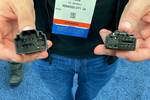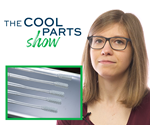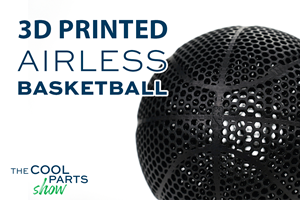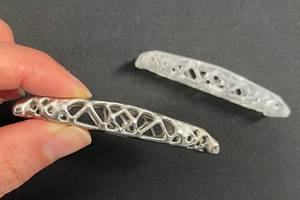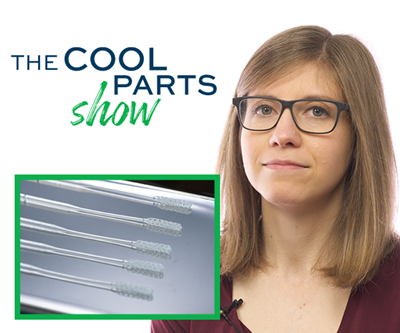The conflict in Ukraine that began on February 24, 2022, has intersections with additive manufacturing (AM). As has happened in other recent emergencies (see: covid 19 and ongoing supply chain challenges), 3D printing is serving as a way to produce needed medical devices and supplies on short notice. We have seen the first major test of Project DIAMOnD, a U.S.-based distributed manufacturing network of more than 300 desktop 3D printers that was recently activated to produce tourniquet components needed in Ukraine. 3D printers in this network and elsewhere in the world have pivoted with relative ease to these tasks, underscoring the agility of this digital manufacturing process. But meanwhile Ukrainians who once had a sense of safety and stability are now living day-to-day, 3D printing users and additive manufacturing professionals among them. Companies innovating in this space have seen their work interrupted and delayed, and their leaders are making difficult decisions about the future of these enterprises even as work goes on. People who had built careers, families and lives have been displaced, separated and irreversibly changed.
In this episode of AM Radio, we share stories of manufacturers and individuals affected by the conflict in Ukraine. These stories touch on everything from the realities of distributed manufacturing to personal experiences on the ground to, above all, a sense of resolve and determination to carry on. Listen above or read on for the transcript and ways that you can help.
Stephanie Hendrixson
Welcome to AM Radio. I'm Stephanie Hendrixson. And we have a little bit of a different episode for you today we are going to be talking about the conflict in Ukraine and additive manufacturing connection the way 3D printing is providing aid the way it's being shaped by this and how some 3D printing users are being affected. That's coming up right after this.
Julia Hider
The AM Radio podcast is brought to you by the Additive Manufacturing Conference at IMTS, the leading industry event focused on 3D printing for production Learn more at AdditiveConference.com.
Stephanie Hendrixson
Welcome to AM Radio. I'm Stephanie Hendrixson. I'm joined in the studio today by both of my cohosts, Pete Zelinski.
Peter Zelinski
Hey.
Stephanie Hendrixson
And Julia Hider.
Julia Hider
Hi, Stephanie.
Stephanie Hendrixson
So we are here to do kind of a special episode. We've been hearing a lot of stories about how 3D printing is being used to assist or is being changed, or people are being affected by the conflict in Ukraine. And I thought we could just do an episode that sort of centers on this. So in the first half of this episode, we're going to talk about distributed manufacturing and how 3D printing can be used for different aid efforts. And then in the second half of the show, we'll hear how one particular additive manufacturing company has been affected. But I think right now we'll start with some things that are going on in the United States. Pete, do you want to jump in with our first example?
Peter Zelinski
Yeah, you mentioned distributed manufacturing. And, as it turned out, the war in Ukraine provided the context for the first real test of a large, distributed manufacturing network. I'm referring to Project DIAMOnD. That's this initiative in Michigan. It's an acronym, Diamond Distributed, Independent And Agile Manufacturing On Demand. It is the partnership between two counties in Michigan, Macomb County, Oakland County, along with Automation Alley, which is this manufacturing focused nonprofit in Michigan. And one of the promises of distributed manufacturing, and really the whole reason for Project DIAMOnD, is that a distributed 3D printer network potentially has manufacturing capacity to respond to emergency needs. Project DIAMOnD came out of the pandemic, it's federally funded, the CARES Act Coronavirus Aid Relief And Economic Security, it's an act in 2020. Funding was provided that these two counties took advantage of to simply allow a lot of manufacturers in these two counties to have 3D printers, every one of them has an identical 3D printer, and as long as they keep material on hand and get themselves trained, they can use the 3D printer for their own purposes. It's just that this distributed network of now 300 3D printers, is capacity that these counties can basically take over in an emergency to provide emergency supplies. We saw 3D printers in all kinds of informal networks producing personal protective equipment during the pandemic, the counties overseeing Project DIAMOnD decided to trigger the network to print components of tourniquet clips that could be used, that could be sent to Ukraine, that were sent to Ukraine. Stephanie, you and I had the chance to visit one of these companies, a node on the Project DIAMOnD network, who saw this happen, this company is benefiting from 3D printing now that it has a 3D printer as a result of this project, but also saw how this capacity was put to use. The company that I'm referring to, Tucker Induction Systems.
Stephanie Hendrixson
Yeah, so Tucker Induction is kind of a poster child for how this project was supposed to work, right? You get a printer for free. And the deal is you get a roll of filament that you're supposed to keep on hand in case of an emergency situation. And so Tucker Induction, they make induction coils like induction heating equipment. And they've found lots of uses for this. It's a Markforged, I think, Mark 2 3D printer. And they found lots of uses for it in their own application in making like custom brackets and other things for their business. But it's also on this network. And that's the thing I didn't quite understand about Project DIAMOnD until we were there that literally all of these printers are connected. And there is like a kind of a switch that gets flipped in the case of an emergency. And so they experienced this with the Ukraine situation. The deal is when this network gets activated, whatever is currently in your print queue gets printed, and then it switches right over to making whatever part is needed that has been requested.
Peter Zelinski
So I've covered manufacturing for a while. And I've seen various public sector initiatives to support and advance manufacturing. And I have various opinions of these various different efforts. Learning more about Project DIAMOnD. I'm pretty bullish on what a smart idea this is particularly as we spent time with Josh Tucker at Tucker Induction Systems and just learning how this manufacturer’s experience is changed as a result of volunteering to be part of this distributed manufacturing network. So this is a company where Josh Tucker knew additive manufacturing is going to be impactful for his business. He's watching it, but he's thinking about 3D printing of copper, their coils are made of copper. And he's still searching for just the right platform and system to do his kind of induction coils, his kind of copper coils cost effectively, and various systems are close. But meanwhile, here was an opportunity to get a 3D printer for free. And he started to discover, there's all these other uses for 3D printing that would help them that he couldn't see because he was focused on copper so much, but there are other components of the coil assemblies that he puts together, that they have to be nonconductive so that the eddy current doesn't generate heat, and some of these are being 3D printed now. There is tooling and resources around the shop he's producing through 3D printing, there are all these ways that 3D printing is put to use and all these ways that the business is learning about the manufacturing benefits of 3D printing. Yeah, you get a printer for free, but there are things you have to do. And he had to go through five days of training to make sure he's ready for this. But then yet the moment came where he saw how his business is now part of something larger and distributed manufacturing, if this if the system is designed well, it can work.
Stephanie Hendrixson
Yeah, something that's striking about Project DIAMOnD is that we've heard from other manufacturers like how difficult distributed manufacturing is, like even different printers within the same facility don't necessarily do the same things all the time, the way you might expect. But in the case of Project DIAMOnD, like the printer hardware itself is simple enough, the printers are similar enough. And the things that they're being asked to make are relatively simple. And so this is a case where distributed manufacturing actually works pretty well.
Peter Zelinski
Yeah. And so what are some of like the requirements of a distributed manufacturing system that works really well? I think we see clues of it with the way Project DIAMOnD worked. Completely identical printers all throughout the network, vetted facilities, everyone gets training, everyone's kind of checked out by Project DIAMOnD first for being a candidate for this. And also the commitment of Markforged, like we heard that from Josh Tucker. And he described just how, how great the Markforged people have been about providing support and, and their presence and commitment within all of the different meetings of this network. So they decided to activate the network, they printed tourniquet components for Ukraine. So then, yeah, Josh Tucker saw this moment come where he saw that he was part of this larger system, and the printer was taken over, the network was activated. First, he watched his printer making, I think, like clips for the tourniquet system. And then at some point, they must have obtained enough quantity of those because they pivoted so that the next build was handles. And you can imagine, no one can predict what the future’s emergency might be. But now there's all this capacity, 300 3D printers in these counties, that can make objects, tools, stuff that's needed in a crisis. And when it's not needed, all these different companies are now taking the next step with additive manufacturing because of these systems.
Julia Hider
Yeah, I wasn't on the shop visit with you, but I saw this play out on social media. I follow a lot of different machine shops on Twitter, and LinkedIn and Instagram. And at least one shop that I saw, posted that they were part of this network and their printer was preparing to print these tourniquet parts. And I knew Stephanie had been following this story for a while now. And so I sent the link to her. And I was like, hey, is this the thing that you've been wanting to write about for a while? And she's like, Yeah, that's it.
Stephanie Hendrixson
Yeah. And it's interesting, like that was a totally different node of Project DIAMOnD that I wasn't even aware of. And we saw that in a couple of different places across social media, people sharing that they were making these parts. The thing I think is really striking is Josh Tucker's account of just like literally watching his printer shift from making one part to a different part. And it's like, there was no cutting tool change. There was no mold swap. You didn't need a robot for this, like it just happened. That's something we talked about with additive a lot like it's not a process that needs tooling. And as a result, it becomes very agile. And the printer doesn't really care what it's making as long as it has the material and it has the build volume, and it has the right settings to make that thing. And I have a story that that sort of relates to that to pivot us back toward Ukraine.
So there is this baker that I've been following on Instagram for four or five years now. Her name's Dinara Kasko and she is a baker who uses 3D printing. She has a couple of different Ultimaker printers which we'll come back to in a minute. But she prints patterns using those printers. So you know, imagine the shape of the cake you ultimately want to bake or the chocolate you will ultimately want to make, print that and then encase it in silicone, remove that printed pattern and the silicone becomes the mold for whatever you want to make. And I only recently just this year realize that she is Ukrainian. She until recently was based in Kharkiv, which is on the east side of the country. It's really close to the border with Russia. It was one of the first cities that was attacked, and it's actually Cincinnati's sister city, we're based in Cincinnati. Both cities are on rivers, we're inland. We have strong manufacturing bases. And so there was kind of a connection there. But I saw this post when it was one of her printers running. And then it was kind of a slideshow of different parts which were clearly not for baking, clearly not for molds. They were tourniquet parts. They were braces and things that were for something different. And so I ended up reaching out to her on Instagram, we talked over WhatsApp and she just sort of told me this story about how she had this life in Kharkiv. She had two different studios where she had video filming equipment, she had baking equipment, she had eight employees that she was working with. And the day that this invasion started, her and her family, they fled, they left. They spent some time in western Ukraine. They eventually made their way to Spain and then Portugal. And I believe right now her and her family are in the UK. And so they were able to get out. But that meant leaving behind her home, leaving behind all this equipment that she had. And she had four Ultimaker printers in total, three of them had been used for making these molds. And then she had a fourth that she had purchased, I think last year but was having some difficulty with it. So she returned it to the distributor that she bought it from which is called Extrusion In Motion and they were sort of trying to work through the issues. And then all of this happened and this printer was left behind. And Extrusion In Motion just kind of rolled it into their print farm, they have about 40 Ultimaker printers that they're now using to make tourniquet parts to make braces to make like periscope devices so that you can look around corners without exposing yourself. It was just like this really, really granular example of how the 3D printer can just easily pivot from making items for these beautiful cakes and confections into making these really necessary and needed medical devices and other items,
Peter Zelinski
This thing that you're describing, and it's a point that's come out a couple times here, but manufacturing capacity that can be quickly deployed redeployed in an emergency, different manufacturing technologies are potentially useful here. But additive manufacturing is distinctive for just as you say, no tooling, no, there's nothing in particular hardware wise, that has to change in a significant way. And she saw that play out and she saw her own printer suddenly quickly being used for something very different. And I wonder, like, do you have a sense of how that felt to her and how she was processing?
Stephanie Hendrixson
I think almost since the beginning like Dinara has been collecting funds like she's running this through her personal Pay Pal right now and passing the money to contacts in Ukraine to provide medical supplies and food and things that are needed. And I think to her like this is just another way to help like publicizing what is happening with her printer with this whole printer farm is a way for her to try and help the people that are still back in Ukraine. One of the things that she said in her interview was just like how lucky she is like to have been able to get out to have had the experience of traveling quite a bit before all of this happened, to be able to speak English very well. And there are a lot of people in Ukraine who don't have the resources to leave or who don't want to leave like that's their home, that's all they've ever known. And I think for her it's really important to try and do everything that she can even though she's not there anymore.
Peter Zelinski
The way that you said like some don't want to leave, this is their home and I'm imagining this print farm and the work goes on like we've had other conversations haven't we of how there are people still in Ukraine and the valuable work they're doing still continues there despite the circumstances?
Stephanie Hendrixson
Yeah, I think we will get to that story and the next half of the show.
Julia Hider
The AM Radio podcast is brought to you by the Additive Manufacturing Conference at IMTS, the leading industry event focused on 3D printing for production. Colocated with North America's largest trade show dedicated to manufacturing equipment, the AMC takes place September 14 and 15th at Chicago's McCormick Place. The conference takes a practical applications-based look at the machines, materials and methodologies being used to 3D print functional components, including both tooling and end-use production parts. The event is designed for owners, executives and engineers, as well as OEMs involved in durable goods manufacturing. Join the Additive Manufacturing team in Chicago for a day and a half of conference sessions and networking opportunities. Find more information and register at AdditiveConference.com.
Stephanie Hendrixson
And we're back. So in the first half of the show, we were talking about how additive manufacturing and 3D printing makes it easy to pivot production to do things like distributed manufacturing, and how that is being applied to the situation in Ukraine for humanitarian assistance for medical supplies and other things. But we've also been in communication with a company that is based in Ukraine. They've got locations across the world now. But they started in Ukraine, they still have employees there. And, Julia, do you want to tell us the story?
Julia Hider
Yeah. So A.D.A.M. Bioprinting is a company that's developing an infrastructure for on demand 3D printed customized medical implants. And we first learned about them when they entered a part in The Cool Parts Showcase last year at the Additive Manufacturing Conference. And we didn't realize that they were based in Ukraine, their R&D team is based in Odessa. And we didn't realize that until they sent an email update shortly after the invasion. And they offered to take some time in the middle of everything that's going on to talk to us about what the situation is like over there generally, and how they've been able to continue to work and some of the ways that they've been able to help. So we were able to set up a Zoom call with the company CEO, Denys Gurak, who is based in Connecticut, and the CTO, Michael Pluzhnik, who was in Odessa. And I apologize if I'm mispronouncing anyone's names here. But yeah, so one of the first things that struck me is that there's this conflict of wanting to stay and fight for their country and wanting to keep people safe. And Michael sent his family including his mother and his daughter and his pregnant wife over to Bulgaria. But there were other colleagues whose families decided to stay. And you know, they mentioned one engineer whose wife gave birth during the first week of the invasion, and their legal counsel who is based in Kyiv had family in Mariupol and they were able to get them out of the city. But that was a really big decision that a lot of them had to make.
Peter Zelinski
They were at a, what I understood to be, kind of a sensitive ongoing phase of the work that involved a cleanroom. And they had a cleanroom that they had rented and all set up for their testing there in Odessa. And they continued, they had experiences of munitions falling, some of them very close. But the situation, frightening though it was, stressful though it was, was at least stable enough to allow them to continue with the work, which they decided to do.
Julia Hider
Yeah, so obviously, they paused operations for a few weeks. And during this period, Michael was volunteering with different groups coordinating food, and shelter and medical supplies and medical training. But you know, eventually they were able to get back to work. So they re-cleaned the cleanroom after the work stoppage, and now they're in the process of doing sterile testing, which is pretty amazing given everything that's going on around them.
Stephanie Hendrixson
Yeah, everything that's going on. And one of the things from Michael's story that stood out was just like how, like the restrictions on everyday life have made doing that work more difficult. Like there are curfews, there are barricades throughout the city to navigate, there are checkpoints. And like, I think he said what used to be like a one-hour trip to the lab is now maybe twice as long, because you have to go through all of these barriers just to do your regular job.
Julia Hider
And then on top of that, you know, he talked a little bit about the situation in Odessa at the time, and he said that, you know, there had been rocket explosions relatively close to his house and just the constant stress of having to listen to what's going on and figure out what's going on around him was a lot to deal with. And he said it was hard to describe, but it had a huge impression on him. And I could tell that just from, you know, that conversation that we had.
Peter Zelinski
I agree, watching him in the Zoom call that we had listening to him like you just you get a sense of someone who's entirely understandably a bit on edge and just kind of going day by day, proceeding with the work. In the course of this, like we learned some things about Ukraine. There's a lot of technology development in Ukraine. It is kind of a locus of technology and engineering activity, lots of tech startups, it's one of those kinds of regions of the world and A.D.A.M. Bioprinting is an example of this and fits right into that context. And the thing about new technologies under development, startup companies like that, the work is already kind of uncertain, and the guiding the work is already kind of an act of initiative and self-starting and like yeah, now here is an incredibly more disrupted situation. But still, it's the kind of work where you can keep going with it if you want to. And we can just sort of see, it's almost as an act of defiance, let's keep doing something valuable. Let's keep moving forward with the idea that we're pursuing. Let's keep creating something like let's not let the invaders stop us from the work we're able to do, as long as there's a way to at least partially keep proceeding with it.
Stephanie Hendrixson
Yeah. And A.D.A.M. Bioprinting is in sort of a unique position, because they are bioprinting, they're trying to do things for medical devices. And so in that original Zoom call, we heard how they were going to be collaborating with some hospitals in the United States to work on like point of care 3D printing, like having an actual 3D printer on site at a hospital to make implants. And Julia and I talked to Denys at RAPID and we heard that there's actually been an update on that.
Julia Hider
Yeah.When we initially spoke to them, they mentioned you know, wanting to eventually relocate the team from Odessa, there was talk of, you know, Canada or Connecticut or in other locations. But when we spoke to Denys at RAPID, he mentioned that the company is now working with the Ukrainian Ministry of Health, to set up production systems in Lviv to be able to 3D print bone implants for wounded soldiers and civilians. So it's similar to the projects they have going on at Mount Sinai in New York, but they'll be able to use their technology to help fellow Ukrainians. Lviv is seen as a safer location because it's on the western edge of the country, so I think the plan right now is to relocate the team to Lviv.
Stephanie Hendrixson
So the striking thing for me in all of these stories is that every Ukrainian that we spoke to was so determined to do something to help. Michael was still there on the ground. He's doing the work for A.D.A.M. Bioprinting. He's also I think, still doing some volunteer work. Dinara is on the other side of Europe, still trying to help. Denys is here in the US and he's been involved in several different efforts. And so I think where we want to leave this today is just want to give listeners a way that you can help, you can contribute if you want to. So here are a couple of options that I found. So one is Together, We Are Strong. This is a consortium of additive manufacturing companies. If you saw the signs at RAPID or other announcements on social media about the silent auction to benefit Ukraine, this is the organization behind that. The silent auction is over, but they're still taking donations. We'll put a link to that and to all of these in the show notes, and any funds raised there go to manufacturing parts for medical and aerospace and also to educational workshops on 3D printing for Ukrainian refugees. Some of the companies involved in that effort have also put together an initiative called Tech Against Tanks. This is a group that's coordinating manufacturing of items through 3D printing, as well as other methods like CNC machining. They're taking donations; they're also looking for people to help manufacture things. So if you want to contribute or help from sort of a manufacturing technology perspective, those are some options. I'll also share two more general ones that Denys suggested. One is United 24. It's an initiative that was started by the Ukrainian president Volodymyr Zelensky. The funds are going towards defense towards medical aid and rebuilding Ukraine. And then there's another one that Denys is personally involved in called Mint for Ukraine. This is actually a really interesting initiative. It's a collection of AI-generated artwork inspired by Ukrainian folk art and some other things. And each one of these pieces of artwork is an NFT that you can mint for free. So if you do that, it becomes a digital asset. It goes on the blockchain. We have a separate episode about the blockchain by the way, if you if you want to learn more about that, but you can mint this artwork for free, it goes into your crypto wallet and then you can sell it and all of the resale proceeds go towards Ukraine. 10% goes to artists and cultural organizations and the other 90% goes to humanitarian support. So those are a few ways that you can help and again, we will put links to all of that and the other things that we discussed in today's episode in the show notes. Thank you for listening.
Peter Zelinski
AM Radio was recorded with help from Austin Grogan and Seth Cooper. The show was edited by Alex Lytle and Stephanie Hendrixson. Our artwork is by Kate Bilberry. AM Radio and Additive Manufacturing Media are products of Gardner Business Media located in Cincinnati, Ohio. I’m Pete Zelinski. Thanks for listening.
Related Content
Airless Basketball Shows Promise of 3D Printed Lattices: The Cool Parts Show Bonus
Successfully matching the performance of a standard basketball demonstrates the control possible over the mechanical properties of digital materials.
Read MoreActivArmor Casts and Splints Are Shifting to Point-of-Care 3D Printing
ActivArmor offers individualized, 3D printed casts and splints for various diagnoses. The company is in the process of shifting to point-of-care printing and aims to promote positive healing outcomes and improved hygienics with customized support devices.
Read MoreThis Drone Bird with 3D Printed Parts Mimics a Peregrine Falcon: The Cool Parts Show #66
The Drone Bird Company has developed aircraft that mimic birds of prey to scare off problem birds. The drones feature 3D printed fuselages made by Parts on Demand from ALM materials.
Read MorePossibilities From Electroplating 3D Printed Plastic Parts
Adding layers of nickel or copper to 3D printed polymer can impart desired properties such as electrical conductivity, EMI shielding, abrasion resistance and improved strength — approaching and even exceeding 3D printed metal, according to RePliForm.
Read MoreRead Next
RAPID + TCT 2022 Report: Advancing into the Next Season of Additive Manufacturing: AM Radio #18
Editors Stephanie Hendrixson, Peter Zelinski and Julia Hider share observations, insights and photos from the latest RAPID + TCT trade show.
Read MoreHow Test Swabs Became 3D Printing's Production Win: The Cool Parts Show #15
Nasopharyngeal swabs for COVID-19 testing are one of the best production cases for 3D printing we've seen, pandemic or otherwise. Why AM is winning on speed, functionality and collaboration.
Read MoreCrushable Lattices: The Lightweight Structures That Will Protect an Interplanetary Payload
NASA uses laser powder bed fusion plus chemical etching to create the lattice forms engineered to keep Mars rocks safe during a crash landing on Earth.
Read More

.jpg;width=70;height=70;mode=crop)
